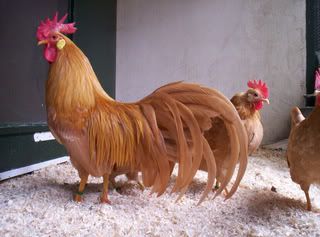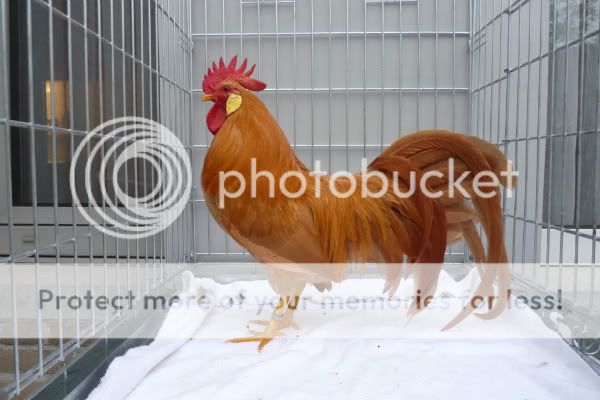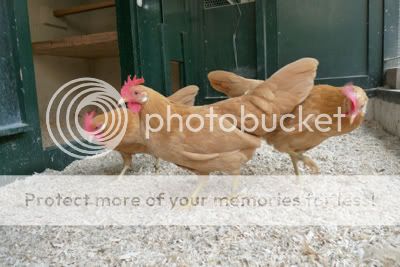I have heard that someone in new mexico has buff leghorns, I sure would like to compile a list and breeders directory for red, black buff leghorns abd white and buff minorcas, it would be nice. Keith
Navigation
Install the app
How to install the app on iOS
Follow along with the video below to see how to install our site as a web app on your home screen.
Note: This feature may not be available in some browsers.
More options
You are using an out of date browser. It may not display this or other websites correctly.
You should upgrade or use an alternative browser.
You should upgrade or use an alternative browser.
Breeding Buff Leghorns
- Thread starter Buff Leghorn
- Start date
I have looked at the tail and saddles on hundreds of Leghorns.It does make a difference on the American type ,backline,and style.It also plays a part on balance and symmetry.I find you do not want a high shoulder,you want cushion or saddle feathers to fill in and build up the back area before the lesser tail coverts,lesser sickles,sickles and main tail.This prevents the break angle at the front of the tail.You need a high tail angle to support the tail weight,the top sickle feathers should be in line with the earlobe. The low tail will prevent the curved backline and will increase the chance of an angle or break at tail.A short tailed Leghorn just does not look right and those with narrow stringy feathers look rough and out of condition.Feather width helps with bloom and condition ,or eye appeal. Feathers take time to grow,especially tail and sickle feathers (about 3-4 months)They seem to grow a bit faster in cold weather.Feathers are fiber and protein,so make sure the diet is good. I like them to get some animal protein regularly(Dog food,beef scraps,beef fat/tallow,mealworms,etc.).Growing or green feathers contain a blood supply and can be a source of feather picking,it is less of a problem with females getting picked.There are many ways to deal with it.Separating the sexes during the brooding and into maturity helps.Free range or lots of space helps.Individual cageing of the promising young males always works. If the tails are fully grown on the males and they are out of blood feather,they can be put into breeding pens while fertile eggs are wanted.For chicks make sure the light is not too strong,lower wattage,and bug lights (yellow bulbs),and that the heat is not too much(use a thermometer).Some people say red lights work,some say it causes eye blindness,so I am not sure on that one.Leghorns are active and need space and exercise,high roosts to fly helps wings develope,free range provides bugs,fresh air,entertainment,and hiding places they can escape(weeds,brush,bushes,trees) from getting picked.Dan Honour
Keith,
My Labrador lives 24/7 with my poultry as well. She has kept the vermin from killing my birds.
Winter seems to be prime time for feather picking and a few years ago I found something that works for me. I have a lot of soft needle evergreens, hemlock and fir. I prune off large branches and put them in the pens with the birds. They spend hours, days, picking off and eating the needles. These are high in vitamin C. It relieves boredom since winter is all about ice and snow here in Vermont, there isn't much opportunity for the birds to scratch. I have not had a feather picking issue since.
Also, feed back your bacon grease, etc any meats to your birds. Unlucky predators end up skinned then the carcasses go to the flock. I also get stuff like fish heads from the grocery and being that I do ice fish, the remains go to my birds. Keeps 'em busy and provides protein and fat during the winter. They love salmon heads.
Dan, great info! I too would like to see more leghorn breeders join in here. My quad is beginning to like me, especially the cockerel. They are enjoying their treat of corn and wild bird seed. Still have only gotten one egg!
My Labrador lives 24/7 with my poultry as well. She has kept the vermin from killing my birds.
Winter seems to be prime time for feather picking and a few years ago I found something that works for me. I have a lot of soft needle evergreens, hemlock and fir. I prune off large branches and put them in the pens with the birds. They spend hours, days, picking off and eating the needles. These are high in vitamin C. It relieves boredom since winter is all about ice and snow here in Vermont, there isn't much opportunity for the birds to scratch. I have not had a feather picking issue since.
Also, feed back your bacon grease, etc any meats to your birds. Unlucky predators end up skinned then the carcasses go to the flock. I also get stuff like fish heads from the grocery and being that I do ice fish, the remains go to my birds. Keeps 'em busy and provides protein and fat during the winter. They love salmon heads.
Dan, great info! I too would like to see more leghorn breeders join in here. My quad is beginning to like me, especially the cockerel. They are enjoying their treat of corn and wild bird seed. Still have only gotten one egg!
Last edited:
- Thread starter
- #64
- Feb 9, 2010
- 52
- 0
- 29
I havn't found the leghorns here to feather pick at all. But they do love to free range...
I have campine as well and they will feather pick i find most of the time it is only one chick that starts all the others if you are quick enough and find the one doin it and take it out of the pen the rest most of the time will be right....
This thread has so much imformation in it and will help so many people that want to breed this colour....
I would just like to thank everyone that has taken the time to make this thread what it is and i hope it keeps goin right through the breeding season and everyone can see what culls look like what good chicks look like and so on.
cheers shane
I have campine as well and they will feather pick i find most of the time it is only one chick that starts all the others if you are quick enough and find the one doin it and take it out of the pen the rest most of the time will be right....
This thread has so much imformation in it and will help so many people that want to breed this colour....
I would just like to thank everyone that has taken the time to make this thread what it is and i hope it keeps goin right through the breeding season and everyone can see what culls look like what good chicks look like and so on.
cheers shane
Last edited:
Some after thoughts. Yes there is variationn how well different strains lay,what size eggs ,shell quality and texture ,and egg shell color. If you have a small flock selection along production lines can be slow.With a large flock you can make progress.Only set the biggest eggs,have a minimum size and stick with it.In a few years raise the bar on egg size a bit.It is said that the best layers lay before 10 am.Most people do not trapnest,but Leghorns should lay 125-220 eggs as pullets under reasonable care,regardless of color variety.
Yes ,if you can catch the culprits quick enough,you can prevent picking,but it is easier said than done. Crowding is a factor.I have had small batches of chicks that had lots of space that never were bothered.A heat source without bright light helps,and free range. I like the sound of pine needle branches and can try that one easy enough. Feeding meat or hanging meat works,but watch so it does not go bad and rancid. I also feed lots of greens,grass,weeds,and clover.
Yes ,if you can catch the culprits quick enough,you can prevent picking,but it is easier said than done. Crowding is a factor.I have had small batches of chicks that had lots of space that never were bothered.A heat source without bright light helps,and free range. I like the sound of pine needle branches and can try that one easy enough. Feeding meat or hanging meat works,but watch so it does not go bad and rancid. I also feed lots of greens,grass,weeds,and clover.
It is more work,but during the breeding season,you can bring each hen to the male for a certain length of time,maybe twice a week.You could put the male in for a time with the entire pen maybe every third day.Work good for a pair or trio,that way the male can stay in good condition for weight and feathers.Some males do not eat enough unless caged for a day or two by themselves. I did this a few years ago when I mated a tiny female to a large male,rather than have the small female beat up so much.It worked,the male became conditioned and would mate very soon after put in her cage.Then he would go back to his cage.I only did this twice a week with good fertility. In another case three females would gang up on a male and have him flying to the roost,acting like a pack of dogs,I got no fertile eggs.When I left the male in the pen alone and put just one hen in with him,it worked and I got fertility.I rotated each of the three females,one day at a time,one at a time.The other two females were caged,they could not gang up as a pack and the male became bold. I like to keep my females grouped so they get along together as a breeding group,then I can rotate males.That way you do not have to re-establish the picking order.It can take weeks to get females used to each other.
A few things you can try if the breeding season is not going good. Keep trying,if there is a will there is a way to get the results.
A few things you can try if the breeding season is not going good. Keep trying,if there is a will there is a way to get the results.
I have a 10 year old black giant hen that does just that every year when I put the males back in for breeding. She tries to kick their butts and wins for awhile, then the males give up on being gentlemen....
I've got two feet of new snow on the ground this morning. Need to shovel the birds out.
I've got two feet of new snow on the ground this morning. Need to shovel the birds out.
Hello,
Sorry for my bad English language, I have never learnd but I will try and do my best.
I am Arie I live in The Netherlands and I raise Buff Leghorns since 1986. First Large Fowl and since 1989 Buff Leghorn Bantams.
In 1994, I imported eggs from the USA. They came from Richard L. Stauder.
On the internet I met Danne J. Honour and he told me the history of my American Type Buff Leghorn Bantams.
The Birds of Richard L. Stauder came from Dan and he have them of Burt Gaude.
I like to conversate with other Buff Leghorn breeders and changing pictures with them.
You are doing a gread yob.......Arie
Here are some pictures of my animals from the past and now.
My best LF Buff Leghorn I ever had

And here some pictures off my American type Buff Leghorn Bantams.



Here F1 White male x Buff female


Here the F2 Pure Buff x F1

Sorry for my bad English language, I have never learnd but I will try and do my best.
I am Arie I live in The Netherlands and I raise Buff Leghorns since 1986. First Large Fowl and since 1989 Buff Leghorn Bantams.
In 1994, I imported eggs from the USA. They came from Richard L. Stauder.
On the internet I met Danne J. Honour and he told me the history of my American Type Buff Leghorn Bantams.
The Birds of Richard L. Stauder came from Dan and he have them of Burt Gaude.
I like to conversate with other Buff Leghorn breeders and changing pictures with them.
You are doing a gread yob.......Arie
Here are some pictures of my animals from the past and now.
My best LF Buff Leghorn I ever had

And here some pictures off my American type Buff Leghorn Bantams.



Here F1 White male x Buff female


Here the F2 Pure Buff x F1

Last edited:
Hi Arie, Welcome! You have very nice birds! Thanks for joining in our discussion.
- Thread starter
- #70
- Feb 9, 2010
- 52
- 0
- 29
Hi Arie and welcome to the thread ....
I'm pleased you have found it . You do have lovely looking birds and i hope the thread can help all buff leghorn breeders no matter what country your in ...
cheers shane
I'm pleased you have found it . You do have lovely looking birds and i hope the thread can help all buff leghorn breeders no matter what country your in ...
cheers shane
New posts New threads Active threads
-
Latest threads
-
Guinea fowl neck broken/sprained?
- Started by Em_ily231
- Replies: 1
-
-
-
I realize I know nothing about chicken breeders and hatcheries...
- Started by Seaslug
- Replies: 0
-
-
-
Threads with more replies in the last 15 days
-
-
-
-
Vent gleet/prolapse/abscess? What am I missing
- Started by FreshObsessed
- Replies: 47
-
-
×

